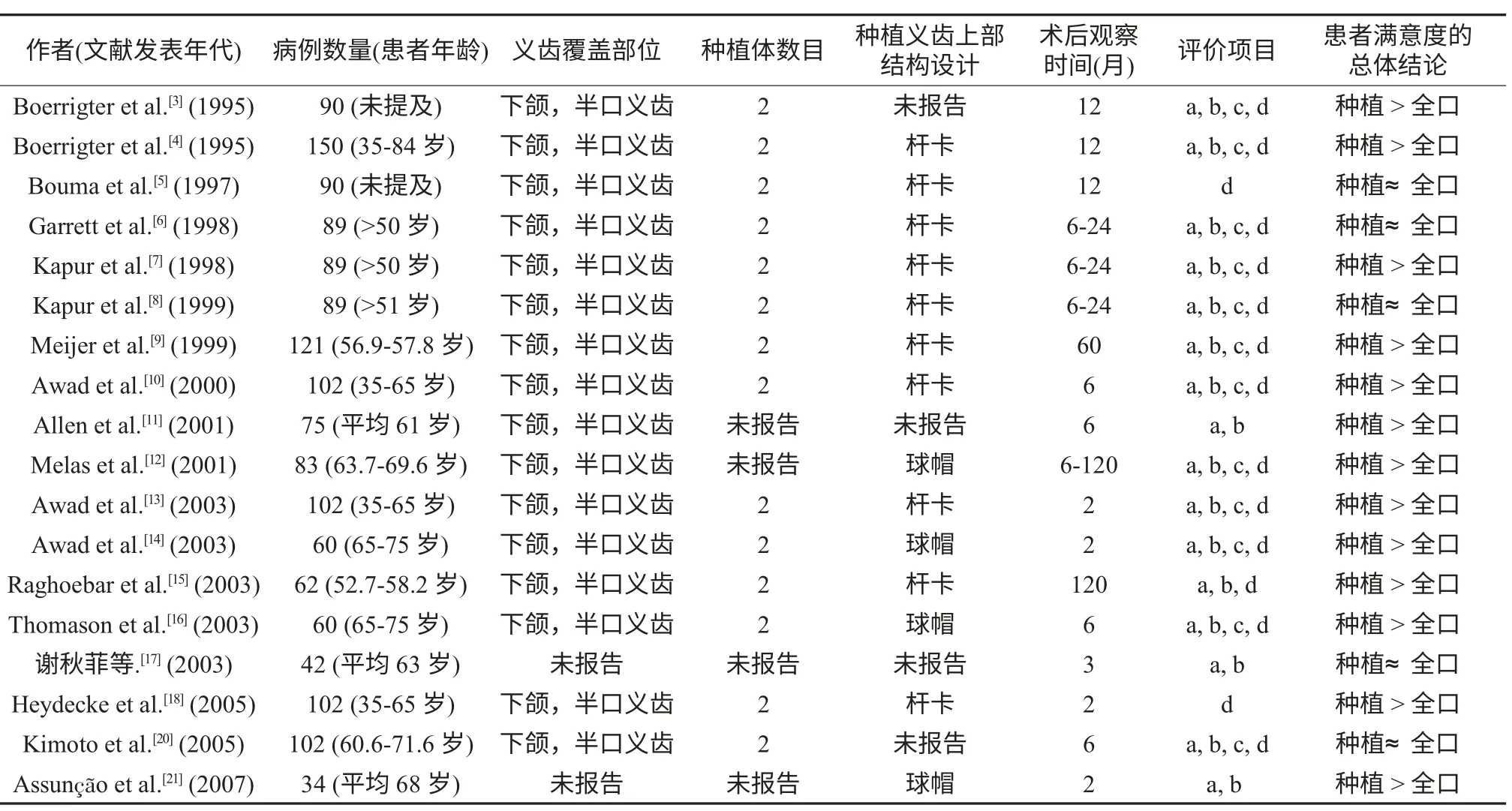循证医学分析下颌牙列缺失患者对不同修复方式的满意度差异
2012-12-23隋秉东许浩坤常奡然
隋秉东 宋 群 许浩坤 常奡然 田 敏 方 明
无牙颌,即整个牙弓上不存留任何天然牙或牙根,又称牙列缺失,是口腔临床的一种常见病。根据第三次全国口腔流行病学调查结果,在我国65-74岁的人群中,患病率为6.8%。无牙颌患者往往无法咀嚼、发音不清,并可出现牙槽嵴吸收和面下部1/3形态改变,造成严重的心理和社会问题。近一个世纪以来,佩戴全口义齿(conventional com plete denture)是无牙颌患者唯一的修复方法,而其固位力与稳定性常受到患者解剖条件的限制而无法进一步提高,患者的咀嚼和发音等功能不能得到根本的改善。
近年来,以2颗或多颗种植体为基础的种植覆盖义齿(implant-retained overdenture)在下颌牙列缺失患者中的应用越来越广泛,它可以使下颌牙列缺失患者摆脱义齿易脱落的困扰,但同时也具有价格昂贵、修理困难等缺点。对于下颌牙列缺失患者,应该推荐种植覆盖义齿还是全口义齿修复有助于获得最佳的综合修复效果目前仍无定论。本文旨在通过循证医学(evidence-based medicine)方法综合分析比较国内外前瞻性随机临床试验(random ized clinical trials)研究中分别经两种修复方式治疗后的患者满意度,以期为下颌牙列缺失患者修复方式的临床选择提供参考依据。
1.材料及方法
1.1文献来源 检索medline、维普数据库和Coch rane协作网上1990-2012年的文献,主要关键词包括“随机临床试验”、“种植覆盖义齿”、“全口义齿”、“无牙颌”以及“患者满意度”,并辅以参考文献追溯[1]、手工检索等方法,共检索到相关文献111篇,其中英文文献93篇,中文文献18篇。
1.2文献纳入及排除标准 (1)依据Jadad评分量表[2],文献须为高质量的前瞻性随机临床试验研究报道;(2)对于随机化方式不清者不予采纳;(3)对于重复报告的文献不予采纳。
1.3文献筛选结果 根据文献纳入及排除标准,经筛选并纳入本文分析的文献共18篇(表1),其中英文文献17篇,中文文献1篇。
1.4分析方法 (1)将18篇文献数据资料录入,建立数据库并进行核校。(2)整理各文献中患者对种植覆盖义齿与全口义齿满意度的资料,计算上述两种修复方式的满意率,应用卡方检验分析两者在不同满意率指标以及整体满意率上是否存在显著性差异(α=0.05)。
2.结果
纳入的18篇文献对于患者满意度的指标可归纳为4个方面(见表1):(1)义齿本身的固位与稳定评价[3,4,6-17,19-21];(2)功能评价,包含咀嚼、发音、味觉、清洁等[3,4,6-17,19-21];(3)美学评价[3,4,6-10,12-14,16,19-20];(4)心理及社会行为评价[3-10,12-16,18-20]。
种植覆盖义齿的优势主要体现在:义齿固位和稳定性好(P<0.05);咀嚼效能强(P<0.05),患者对坚果等硬质食物较少有逃避倾向;美学效果好(P<0.05);对于患者谈话、亲吻等社交行为影响小(P<0.05)。全口义齿仅仅在方便清洁、花费及耗时少方面(P<0.05)占优势。对味觉的影响和义齿气味等方面二者并未表现出显著性差异(P>0.05)见表2。经卡方检验,接受种植覆盖义齿的下颌牙列缺失患者的整体满意度显著优于接受全口义齿的下颌牙列缺失患者(P<0.05)见表3。

表1 纳入文献数据整理

表2 下颌牙列缺失患者对种植覆盖义齿和全口义齿满意度不同评价项目的统计检验结果
3. 讨论
3.1前瞻性问卷调查的可行性 义齿修复效果的客观评价常依赖咀嚼效能测试、牙槽嵴吸收水平的影像学分析等方式。然而,以上方法更大程度地受制于不同设备条件和不同检测手段的影响,不同地区的评价结果往往难以合并比较,并且有时与主观评价的结果相悖[21]。鉴于主观评价在方便快捷、低廉易行、易于评价心理社会影响等方面的优势,针对患者满意度的义齿修复效果的主观评价广为应用。主观评价研究分为两种类型:一种是根据患者对旧义齿的回忆,采集得到的对新旧义齿的满意度比较,属于回顾性研究[22],存在着较大的回忆偏倚;另一种是按患者采取的不同修复方式分组并追踪观察一定时间,在此期间开展的问卷调查,属于前瞻性研究,它的调查结果是否可靠和可比依赖于调查标准是否统一。口腔流行病学已经使用诸如口腔健康相关生存质量(OHRQoL)[23]和口腔健康影响程度量表(OH IP)[24]等评估口腔健康状况的国际标准化调查问卷,并且多数问卷使用视觉模拟评分法(VAS)作为评分依据。我国研究者结合国情已形成改良的OH IP[25]。
3.2可能存在的偏倚 (1)选择偏倚:由于患者对于修复方式必须知情同意,研究难以达到双盲的要求,患者的意愿和预期值或许会影响调查时的评分。而若仅仅纳入那些服从治疗分配方案的患者,他们关于修复方式的治疗动机亦将影响试验结果。目前最好的解决方式是采用意向治疗分析(Intention to treat analysis)[26],即要求患者随机接受任一种修复方式,无论他们是否完成了试验,或者是否真正接受了该种修复方式,都保留在原组进行结果分析。(2)就诊机会偏倚:研究对象多为全口义齿修复效果不满意需要重做、或是新近的下颌牙列缺失患者,因而患者中对全口义齿不满意的比例在基线水平就可能高于种植覆盖义齿。(3)信息偏倚:不排除患者因“牙科恐惧”,倾向于少接受医师检查而勾选“满意”项目的可能性,并且患者还可能存在夸大或低估自身感受的可能。(4)无应答偏倚:患者在研究中途失访不排除其对修复体不满意而退出项目的可能性。
3.3研究前景 随着我国逐渐进入老龄化社会,无牙颌患者的数量将越来越多。在无牙颌患者的修复过程中,口腔医疗行为对患者的心理社会影响正逐步受到人们的重视,修复后评估的重点也从对义齿状况的单一评估转向患者的社会行为学研究。为更加全面而严谨地评价下颌牙列缺失患者对不同修复方式的满意度差异,进一步的研究可以在以下方面开展:(1)开展多中心随机对照试验,尽可能扩大样本含量并争取做到双盲;(2)长期随访,并进行高标准的Meta分析;(3)对种植覆盖义齿的不同亚型修复效果进行进一步的比对分析,如对杆式、球帽式、磁附着式及套筒冠式种植修复的并发症发生率进行随机对照试验比较,获得更有针对性、更有临床意义的结果。
4.结论
总体而言,种植覆盖义齿患者满意度高于全口义齿。临床上应根据患者的具体需求、结合两者的不同优势,为患者推荐最适宜的修复方式,以期获得最满意的修复效果。
[1] Assunção WG,Barão VAR,Delben JA,et al.A comparison of patient satisfaction betw een treatment with conventional com plete dentures and overdentures in the elderly: a literature review[J].Gerodontology,2010,27(2):154-162
[2]Jadad AR,MooreRA,CarrollD,et al.Assessing thequality of reporters random ized clinical trials isb linding necessary[J].ControlClin Trials,1996,17(1):1-12
[3] Boerrigter EM,Stegenga B,Raghoebar GM,et al.Patient satisfaction and chew ing ability with imp lant-retained m andibu lar overdentures:a com parison with new com plete dentures with or without prep rosthetic surgery[J].J Oral Max illofac Surg,1995,53(10):1167-1173
[4] Boerrigter EM,Geertm an ME,van Oort RP,et al.Patient satisfaction with im plant-retainedm andibu lar overdentures.A comparison with new com plete dentures not retained by im plants-am ulticenter random ized clinical trial[J].Br JOral Max illofac Surg,1995,33(5):282-288
[5] Bouma J,Boerrigter LM,van Oort RP,et al.Psychosocial effects of imp lant-retained overdentures[J].Int J Oral Max illofac Im plants,1997,12(4):515-522
[6] Garrett NR,Kapur KK,Ham ada MO,et al.A random ized clinical trial com paring the efficacy of mandibular im plant-supported overdenturesand conventionaldentures in diabetic patients.Part II. Com parisons of m asticatory performance[J].JProsthet Dent,1998,79(6):632-640
[7] Kapur KK,Garrett NR,Hamada MO,et al.Random ized clinical trial com paring the eficacy of mandibular im plant-supported overdentures and conventional dentures in diabetic patients.Part I:methodology and clinical outcom es[J].JProsthet Dent,1998,79(5):555-569
[8] Kapur KK,Garrett NR,Ham ada MO,et al.Random ized clinical trial com paring the efi cacy of mandibular implantsupported overdenturesand conventional dentures in diabetic patients.Part III:com parisons of patient satisfact ion[J].J Prosthet Dent,1999,82(4):416-427
[9] Meijer HJ,Raghoebar GM,van’t Hof MA,et al.Im plantretained mandibu lar overdentures com pared with complete dentures;a 5-years’ follow-up study of clinical aspects and patient satisfaction[J].Clin Oral Im plants Res,1999,10(3):238-244
[10]Aw ad MA,Locker D,Korner-Bitensky N,et al.Measuring the effect of intra-oral im plant rehabilitation on health-related quality of life in a random ized controlled clinical trial[J].JDent Res,2000,79(9):1659-1663
[11]A llen PF,M cM illan AS,W alshaw D.A patient-based assessment of im plant-stabilized and conventional comp lete dentures[J].JProsthet Dent,2001,85(2):141-147
[12] Melas F,MarcenesW,W right PS.Oral health impact on daily performance in patientswith imp lant-stabilized overdentures and patients with conventional comp lete dentures[J].Int JOralMaxillofac Im plants,2001,16(5):700-712
[13] Aw ad MA,Lund JP,Du fresne E,et al.Com paring the ef fi cacy of mandibu lar im plant-retained overdentures and conventional dentures among m idd le-aged edentulous patients:satisfaction and functional assessment[J].Int J Prosthodont,2003,16(2):117-122
[14] Aw ad MA,Lund JP,Shapiro SH,et al.Oral health status and treatm ent satisfaction with m andibu lar im plant overdentures and conventional dentures:a random ized clinical trial in a senior population[J].Int JProsthodont,2003,16(4):390-396
[15]Raghoebar GM,Meijer H JA,van’t Hof M,et al.A random ized prospective clinical trial on the effectiveness of th ree treatm ent m odalities for patients with low er denture prob lem s.A 10 year follow-up study on patient satisfaction[J].Int JOralMax illofac Surg,2003,32(5):498-503
[16]Thom ason JM,Lund JP,Chehade A,et al.Patient satisfaction with mandibu lar im plant overdentures and conventional dentures 6 months after delivery[J].Int J Prosthodont,2003,16(5):467-473
[17]谢秋菲,陈 利,冯海兰,等.总义齿、覆盖义齿和种植覆盖义齿修复后患者满意度的比较研究[J].现代口腔医学杂志,2003,17(2):127-129
[18] Heydecke G,Thom ason JM,Lund JP,et al.The im pact of conventionaland im plant supported prostheses on socialand sexual activities in edentulous adults.Results from a random ized trial 2m onthsafter treatment[J].JDent,2005,33(8):649-657
[19] K imoto K,Garrett NR.Effects of mandibu lar ridge heigh t on patients’perceptionswith m andibular conventional and imp lant-assisted overdentures[J].Int J Oral Maxillofac Im plants,2005,20(5):762-768
[20] AssunçãoWG,Zardo GG,Delben JA,et al.Comparing the efi cacy of mandibular im plant-retained overdentures and conventional dentures am ong elderly edentu lous patients:satisfaction and quality of life[J].Gerodontology,2007,24(4):235-238
[21] Slagter AP,Olthoff LW,Steen WH,et al.Comm inution of food by com plete-denturew earers[J].JDent Res,1992,7(2):380-386
[22] Hobkirk JA,Abdel-Latif HH,How lett J,et al.Prosthetic treatment timeand satisfaction of edentu louspatients treated with conventional or im plant-supported com plete mandibular dentures:a case-control study(Part 1)[J].Int J Prosthodont,2008,21(6):489-495
[23] Slade GD,Strauss RP,A tchison KA,et al.Conference summary:assessing oral health outcom es-measuring health statusand quality of life[J].Community Dent Health,1998,15(1):3-7
[24] Slade GD,Spencer AJ.Development and evaluation of the Oral Health Im pact Profile[J].Comm unity Dent Health,1994,11(1):3-11
[25] 刘佳钰,陈卓凡.中文版口腔健康影响程度量表(OH IP-49)的研制[J].临床口腔医学杂志,2011,27(8):469-472
[26] Em am i E,Heydecke G,Rom pre PH,et al.Im pact of im plant support for m andibular dentures on satisfaction,oral and general health-related quality of life:a m etaanalysis of random ized-controlled trials[J].Clin Oral ImplantsRes,2009,20(6):533-544
